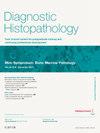Diagnosis of chronic myeloid neoplasms and approach to germline predisposition in children
引用次数: 0
Abstract
Chronic myeloid disorders in the pediatric population include myelodysplastic syndrome/neoplasm (MDS), juvenile myelomonocytic leukemia (JMML) and similar disorders, such as Noonan syndrome-associated myeloproliferations, and myeloproliferative neoplasms (MPNs) including chronic myeloid leukemia, mastocytosis, polycythemia vera, essential thrombocythemia, and primary myelofibrosis. These disorders pose significant diagnostic complexities due to their rarity and overlap with reactive conditions. This review examines the distinctive clinicopathologic features of chronic myeloid neoplasms occurring in childhood, emphasizing the importance of a comprehensive diagnostic approach that integrates clinical assessment, morphologic analysis, immunophenotyping, and genetic studies. Special attention is given to germline predisposition syndromes and their implications for diagnosis and management, including GATA2 deficiency, SAMD9/SAMD9L disorders, severe congenital neutropenia, Fanconi anemia, telomere biology disorders, familial platelet disorders, and germline variants in ERCC6L2, CEBPA, DDX41, and TP53, among others. MDS occurring in the setting of insertional mutagenesis after gene therapy is discussed. Emphasis is placed on the description of reactive non-neoplastic conditions that may mimic myeloid neoplasia in the pediatric setting. The pathologist's role is crucial in recognizing subtle morphologic clues and integrating them with molecular findings to distinguish these entities from germline disorders and benign processes.
儿童慢性髓系肿瘤的诊断及种系易感性的探讨
儿童人群中的慢性髓系疾病包括骨髓增生异常综合征/肿瘤(MDS)、少年髓单细胞白血病(JMML)和类似疾病,如Noonan综合征相关的骨髓增生,以及骨髓增生性肿瘤(mpn),包括慢性髓系白血病、肥大细胞增多症、真性红细胞增多症、原发性血小板增多症和原发性骨髓纤维化。由于这些疾病的罕见性和与反应性疾病的重叠性,这些疾病构成了显著的诊断复杂性。本文回顾了儿童期发生的慢性髓系肿瘤的独特临床病理特征,强调了综合临床评估、形态学分析、免疫表型和遗传研究的综合诊断方法的重要性。特别关注种系易感性综合征及其对诊断和管理的影响,包括GATA2缺乏、SAMD9/SAMD9L疾病、严重先天性中性粒细胞减少症、范可尼贫血、端粒生物学疾病、家族性血小板疾病、ERCC6L2、CEBPA、DDX41和TP53等种系变异。讨论了基因治疗后插入突变发生的MDS。重点放在反应性非肿瘤条件的描述,可能模仿髓系肿瘤在儿科设置。病理学家的角色在识别细微的形态学线索并将其与分子发现相结合以区分这些实体与种系疾病和良性过程方面至关重要。
本文章由计算机程序翻译,如有差异,请以英文原文为准。
求助全文
约1分钟内获得全文
求助全文
来源期刊

Diagnostic Histopathology
Medicine-Pathology and Forensic Medicine
CiteScore
1.30
自引率
0.00%
发文量
64
期刊介绍:
This monthly review journal aims to provide the practising diagnostic pathologist and trainee pathologist with up-to-date reviews on histopathology and cytology and related technical advances. Each issue contains invited articles on a variety of topics from experts in the field and includes a mini-symposium exploring one subject in greater depth. Articles consist of system-based, disease-based reviews and advances in technology. They update the readers on day-to-day diagnostic work and keep them informed of important new developments. An additional feature is the short section devoted to hypotheses; these have been refereed. There is also a correspondence section.
 求助内容:
求助内容: 应助结果提醒方式:
应助结果提醒方式:


